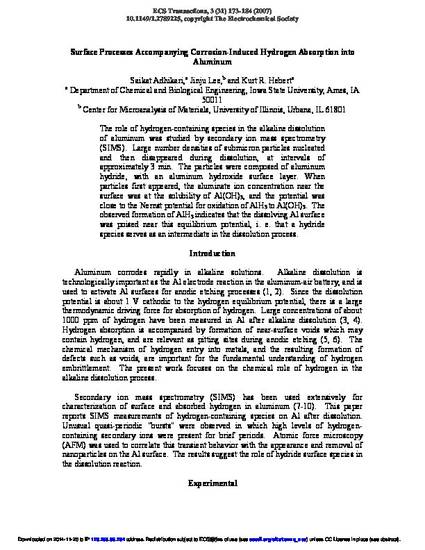
Presentation
Surface processes accompanying corrosion-induced hydrogen absorption into aluminum
Chemical and Biological Engineering Conference Presentations and Proceedings
Document Type
Conference Proceeding
Conference
210th ECS Meeting
Publication Date
1-1-2006
DOI
10.1149/1.2789225
Geolocation
(21.161908, -86.85152790000001)
Abstract
The role of hydrogen-containing species in the alkaline dissolution of aluminum was studied by secondary ion mass spectrometry (SLMS). Large number densities of submicron particles nucleated and then disappeared during dissolution, at intervals of approximately 3 min. The particles were composed of aluminum hydride, with an aluminum hydroxide surface layer. When particles first appeared, the aluminate ion concentration near the surface was at the solubility of Al(OH)3, and the potential was close to the Nernst potential for oxidation of AlH3 to Al(OH)3. The observed formation of AlH3 indicates that the dissolving Al surface was poised near this equilibrium potential, i. e. that a hydride species serves as an intermediate in the dissolution process.
Rights
© The Electrochemical Society, Inc. 2007. All rights reserved. Except as provided under U.S. copyright law, this work may not be reproduced, resold, distributed, or modified without the express permission of The Electrochemical Society (ECS).
Copyright Owner
The Electrochemical Society
Copyright Date
2007
Language
en
Citation Information
Saikat Adhikari, Jinju Lee and Kurt R. Hebert. "Surface processes accompanying corrosion-induced hydrogen absorption into aluminum" Cancun, Mexico(2006) Available at: http://works.bepress.com/kurtr_hebert/51/

The archival version of this work was published in S. Adhikari, J. Lee and K. R. Hebert, "Surface Processes Accompanying Corrosion-Induced Hydrogen Absorption into Aluminum," ECS Trans., 3, (31) 173-184 (2007). doi: 10.1149/1.2789225